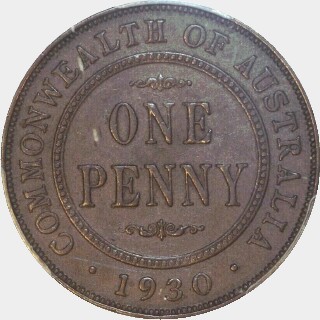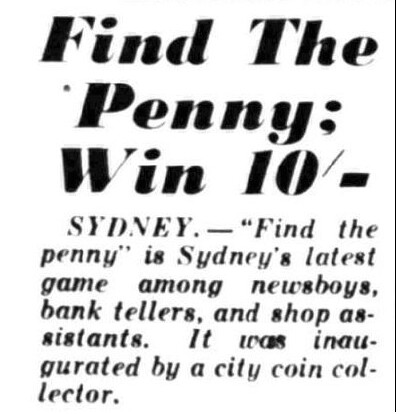



?
The 1930 penny is the most famous Australian coin and one of the world's most valuable circulating copper coins. Its fame originates from the 1940s and 1950s where its rarity was first revealed to the general public, thus creating a surge in interest. Consequently, the average 1930 penny only circulated for 15-20 years leaving the average grade at around the Fine to VF level, slightly higher than pennies from surrounding years. This interest has lasted giving the 1930 penny the title of Australia's Glamour coin, and the key date to every penny collector's set. Consequently, despite a relatively high estimated mintage of 2000-3000 pieces, the 1930 penny commands prices similar to much rare coins such as pre-decimal proofs.
In 1930 Australia was suffering severly from the Great Depression. The reduced overall demand for currency led the treasury not to request any pennies to be struck that year. Despite this a small number of dies were prepared and it has been suggested that visiting dignitaries were permitted to purchase fresh 1930s pennies from the mint. This would seem to contradict the minimal number of upper grade examples of the date, with no known examples in mint state. It is more likely that the coins were struck to test the dies as suggested Andred Crellin.
The coin is fairly scarce in lower grades with about 1500 pieces in the market today, above XF the coin becomes very rare and is almost unhead of in AU grades. Three reverse dies are known to have been used for specimen strikes; these are combined with English and Indian obverse dies. The coin usually features a central strike weakness on the reverse and is almost always paired with an Indian obverse die. Only three extant English obverse types are known today. At the end of 1930, the Melbourne Mint also produced proof strikes for various museums and as proof of record pieces for the mint.
The fever surrounding the 1930 Penny seems to have first emerged in 1945 when Sydney numismatist Mr. George Raymond advertised that he would pay ten pounds for any examples of the 1930 Australian Penny. (The Sun, 1945) The advertisement quickly captured the public's attention and over the following months the "Find the penny" sensation was featured in newspapers around Australia. One article stated that a city bank teller had gone through nearly ten thousand pennies but was unable to find any examples. (News, 1945) After the initial hype the story further developed when an official from the Commonwealth Crown Solicitor's Department stated that Mr. Raymond had been breaking the law and so had the twenty people who had offered to sell him a coin. National Security Regulations states that it is an "...offence to pay, give, or accept any amount greater than the face value of a coin, for such a coin..." (The Sun, 1945)

Find out what dealers are paying with a subscription.
Subscribe now!Find out what coins have actually sold for and where with a Standard/Professional subscription.
Subscribe now!